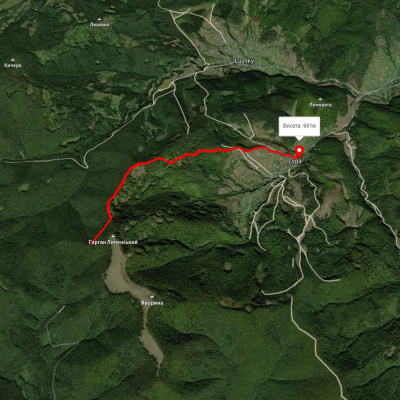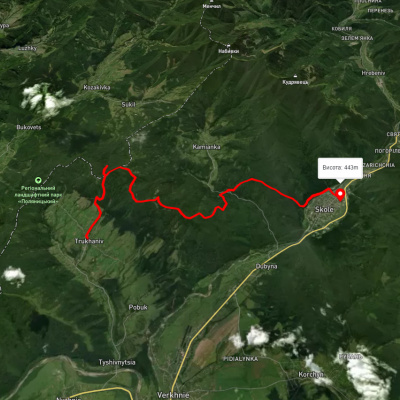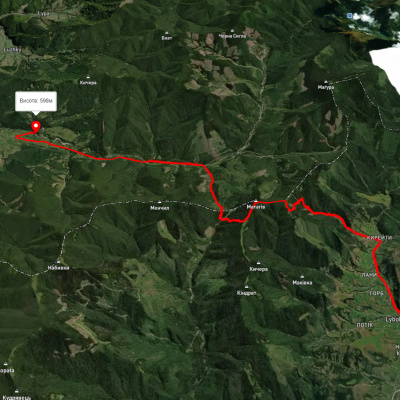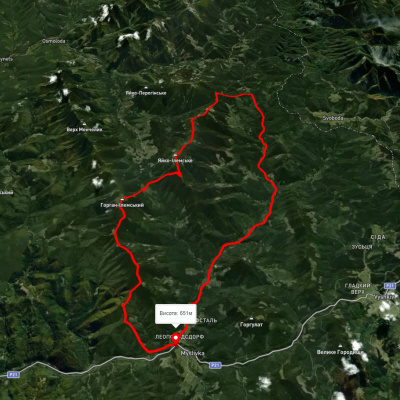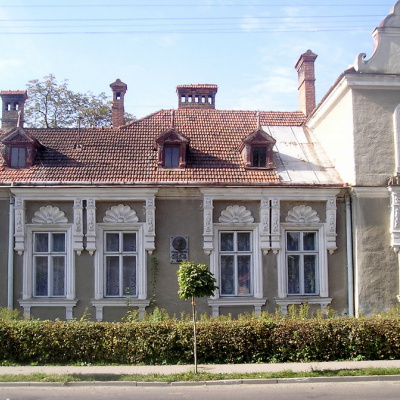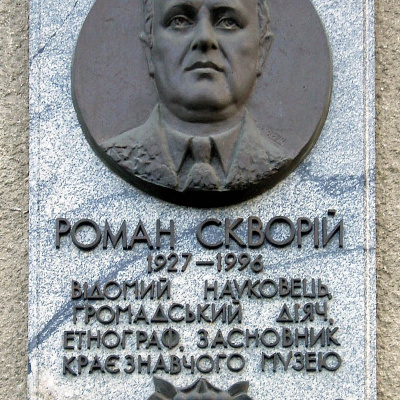It was founded on November 28, 1967, by local historian and enthusiast Roman Skvoriy. The impetus for the collecting work was the preparation for the 40th anniversary of Natalia Kobrynska's death, which was in January 1960. After all, more than 30 years of work of this writer and public figure in Bolekhiv and beyond left a deep mark in the memory of many generations. And in 1964, a local history room was opened at the library.
In 1970, the museum was awarded the title of People's Museum. Publications about its local history work appeared in the Ukrainian Historical Journal, the Ukrainian Language and Literature at School magazine, the Literary Ukraine newspaper, and in the regional and local press. The collected materials were brought to the public through publications of local history research in the press. In 1987, an order was issued to reconstruct the local history museum into a museum of the city's history.
The museum's local history work gained publicity and popularity, as evidenced by the facts of new unique acquisitions for the exhibition: fragments of 17th-century manuscript liturgical books from the ancient monastery and church of Dovzhky village, a series of photographs from the period of the famous Ukrainian sculptor Mykhailo Chereshnevsky's stay in Bolekhiv (1939-1944), and Metropolitan Andrey Sheptytsky (1909). A valuable gift was transferred from Stryi - sheet music written by T. Bobrynsky to an emigrant song with N. Kobrynska's own stamp.
On April 14, 1999, according to the order of the Department of Culture of the Ivano-Frankivsk Regional State Administration, the museum became a state museum. It is housed in six halls. The exposition consists of the following sections: "History of the City of Bolekhiv"; "Boyko's Room"; "Development of Industry, Education, and Culture in the 20s and 30s of the Twentieth Century"; "World War II, Victims of Nazi and Bolshevik Occupation"; "National and Spiritual Revival of Our Land"; "Struggle of the Ukrainian People to Establish Their Statehood".
In addition, in the basement of the museum, there is a memorial torture chamber where residents of Bolekhiv and surrounding villages served their sentences between 1944 and 1947. During this time, dozens and dozens of people went through the group casemate, as evidenced by various records on the basement walls.
His fellow countrymen appreciated the ascetic work of R. Skvoriy. On the occasion of the 70th anniversary of his birth and the 30th anniversary of the museum, a memorial plaque was installed on the library building where he worked for a long time. In accordance with the decision of the 11th session of the Bolekhiv City Council of 07.02.2007 "On honoring the memory of Roman Skvoriy," the Museum of History of Bolekhiv was named after its founder. The museum staff conducts sightseeing and thematic excursions, literary hours and consultations, local history and ethnography lessons, various exhibitions, and conferences.
2005 was named the year of Natalia Kobrynska in Bolekhiv. On October 16, 2005, a new
museum building was opened with an exposition about the famous Galician writer and public figure Natalia Kobrynska. The exposition includes the following sections: "Beleluia", "Bolekhiv in the time of Natalia Kobrynska", "Natalia Kobrynska in the circle of contemporaries", "Memorial corner", "Bolekhiv honors the memory of the writer", "Natalia Kobrynska and Sich Riflemen", "Natalia Kobrynska and Ivan Franko".
Working days: Sunday through Friday. Day off: Saturday. Opening hours: from 8:00 to 17:00; Sunday: from 9:00 to 16:00. Admission is free. For a group - 30 UAH. Video recording - 30 UAH. Photography - 20 UAH.
The museum is included in the list of objects checked for accessibility for people with special needs.
In the Bolekhiv History Museum, they talked about a man of clear conscience, unusual fate, and unique talent - Roman Skvoriy (Skvarii). He devoted more than a dozen years of conscientious work to the foundation and development of the museum. His talent as a local historian, publicist, writer and public figure blossomed here.
Volodymyr Rudyi (Roman Skvoriy's real name) was born and raised in Kulychkiv, a small village in the Sokal region. Roman Skvoriy's path to self-affirmation was not easy. The material hardships of the postwar period, suspicion and persecution, and the lack of reliable personal documents were only part of his ordeal. Thanks to good people and loyal friends, he managed to survive and get an education. After graduating from the Lviv Cultural and Educational College, he moved to Bolekhiv in 1951 to work. Since then, he has been forever associated with the Boykivshchyna. His "Song about Bolekhiv" radiates sincere love for our city. It was first performed at the majestic celebration of its 620th anniversary, and in 2002 it was recognized as the anthem of Bolekhiv.
In his conversations, R. Skvoriy never mentioned the past or his family. And when he was called Roman Skvoriy, he took this change as another opportunity to protect himself from the watchful eyes of suspicious spies. For Roman Skvoriy, local history became the only possible way to learn about and popularize Ukrainian history and cultural heritage. He researched the past of the entire Dolyna region, but dreamed of recreating the chronicle of his native Kulychkiv. Out of his love for Ukraine, experience, and hard work, the museum of our town was born, and it contains evidence of the material and spiritual culture of Bolekhiv and the surrounding area, memoirs, publications, and photographs about the life and work of the famous writer and women's movement organizer Natalia Kobrynska.
Roman Skvoriy's interest in the past of the Ukrainian people did not coincide with the communist ideology and the history it imposed. The authorities resumed covert surveillance of him. Three years after the museum was granted the status of a national museum, it was closed under the guise of reconstructing the expositions, and its founder and director were removed from their favorite work.
However, Roman Skvoriy did not stop his research: he collected ethnographic material, memories, and photographic evidence of the liberation struggle in our region, worked in archives, organized the information he had collected, and published articles in periodicals. He studied the unique monument of Ukrainian literature "The Tale of Igor's Campaign", made a poetic translation and gave his own explanations to the text. In his response to the manuscript of the translation of the Tale of Igor's Campaign, Yaroslav Isayevych wrote: "The translation by the famous local historian, founder of the Bolekhiv Folk Museum, R. T. Skvoriy, will be a new and original translation among Ukrainian translations. Without imitating any of the previous translations, the author combines the desire for accuracy with undoubted artistry. If we perceive "The Word" as a poem, this is determined not only by the poetic nature of the figurative system but also by the rhythmic structure of the text. The translator did not depart from the spirit of the original, taking care of the rhythm and melodic alternation of accents. There are some questionable passages, but in any translation there are none. Departing from the generally accepted interpretations in some places, the author of the new translation focuses our attention on the versatility of the content, and promotes the search for more perfect counterparts."
The late 80s and early 90s of the last century witnessed the resumption of state-building processes in Ukraine. R. Skvoriy became the most active participant and leader of this movement in the Bolekhiv region. What he had always dreamed of-a free and independent state-was beginning to come true. At that time, Prosvita was revived and the Union of Ukrainian Women was created, and they established close cooperation with educational and cultural institutions.
The revival of spirituality, historical memory, and cultural heritage were the common steps of the Bolekhiv community, which was trying to become part of the Ukrainian nation. These aspirations resulted in crowded rallies and gatherings, honoring famous people of the region, and celebrating anniversaries. One such crowded celebration was the unveiling of a monument to Natalia Kobrynska in June 1990. On that day, the song about Kobrynska, "Stages of Pain and Struggle," was performed for the first time, co-authored by Roman Skvoriy and composed by Vasyl Stetsyk from Dolyna.
Thanks to Roman Skvoriy, Bolekhiv residents celebrated the city's 620th anniversary for the first time since its founding. At his suggestion, the coat of arms of our town was approved, old street names were restored and new ones related to Ukrainian history were given. With his contribution from the sale of the book "On Bolekhiv's Viznokoloky" he initiated the creation of a fund for the construction of a monument to Ivan Franko in Bolekhiv. R. Skvoriy ensured that the unique natural monument "Dovbush's Rocks" received state status as a historical and cultural monument. On his initiative, a monument to N. Kobrynska was erected and her grave was restored. He found the grave of the priest and writer Mykhailo Petrushevych at the Voloskyi cemetery in Bolekhiv.
While working in the library, Roman Skvoriy was interested in the hobbies of readers, especially young people, and he knew how to listen to everyone, and his interlocutors valued his opinion. That is why Yurii Pronenko, Vasyl Oliinyk, Vasyl Shchehliuk, and Stepan Barabash left so many sincere and grateful words in their poetry to their colleague.
In the memory of the poet-educator Vasyl Oliinyk, R. Skvoriy will forever remain a lover of life, a man of strong convictions, an expert in history and literature. Here is how he remembered our countryman: "Roman Skvoriy was well known in Bolekhiv and respected in Dolyna. We had the honor of communicating with him in the academic circles of Ivano-Frankivsk and Lviv. Always friendly, sensible, and meticulous about everything that happens in society, he had irreplaceable authority among his colleagues, friends, and neighbors."
Roman Skvoriy had a great gift of persuasion. He looked for followers among gifted young people. Under his influence, some of them radically changed their hobbies and preferences, and even their occupation or profession.
Liudmyla Freiiv, director of the Dolyna Centralized Library System, always remembered her colleague fondly: "He was unsurpassed in his work, a true professor, a national academician. They say that there are no irreplaceable people, but the absence of our teacher and advisor is still felt today. We went to him for experience and learned not only the profession, but also dedication, frugality, humanity..."
Skvoriy was a deputy of the district council of the first democratic convocation, chairman of the coordinating council of political parties and public organizations. Oleh Dudar, former chairman of the Dolyna District Council, who has known Roman Skvoriy since the creation of the Ukrainian Language Society in 1989, remembers him as a well-versed person: "I used to ask him for advice, and in those years, as now, a wise word meant a lot. And many decisions depended on Roman Teodorovych's balanced and convincing words. He was a deputy who is sorely missed today. He could not stand aside from the processes that were taking place in the region. and he was devoted to them with all his heart. You could rely on Roman Skvoriy in any matter, he knew how to defend his position."
More than 30 years of research work by R. Skvoriy have resulted in a significant contribution to the field of local history. He began with the life story of one person, Natalia Kobrynska, and revealed to us the history of centuries, dating back to the distant past. He managed to present his many years of research in his books: "On the Bolekhiv Viznokoloky", "The Riddle of Bubnyshche?", "Battles in Bolekhiv", "Echoes of the Middle Ages", "Ozarkevychs - a Family of Ascetics", and numerous articles on local history. For his many years of work and significant contribution to the preservation of the historical and cultural heritage and natural treasures of Ukraine, he was recognized as a laureate of the Ivan Vahylevych Regional Prize in Local History (1992) and posthumously awarded the title of Honorary Member of the Union of Local History of Prykarpattia (1996). Five years ago, the
Р. A documentary film "In the Mirrors of Eternity..." (directed by Roman Sobol) was made about R. Skvoriy, which reflects the entire life of our countryman.
In the last years of his life, he worked a lot, trying to accomplish as much as possible. He hoped to finish writing his memoirs. But it was not to be... He passed away unexpectedly on February 20, 1996.
Time inexorably takes away from us the best people - hardworking and sacrificial, talented and authoritative. From the distance of years, we realize the value of their scientific, creative, and spiritual heritage. Roman Skvoriy will always be remembered by his research books, the street named after him, and the memorial plaque on the building of the library where he worked. And the Roman Skvoriy Museum of the History of Bolekhiv is one of the best museums in Prykarpattia, which will celebrate its half-century anniversary this year.
Halyna SKVORIY-YAKYMIV, researcher at the Roman Skvoriy Museum of History in Bolekhiv
Important information. - Experienced guides of the Boikivshchyna (Dolyna) Museum will help you organize sightseeing tours of Dolyna if you want to see the Museum of Insurgent Victory in Dolyna, the old saltworks, the bunker where Ukrainian nationalists were hiding, the Carpathian Tram in Vyhoda, Dovbush Rocks in Bubnyshche, Shyrkovets Sw amp and Mizun Waterfalls near Novyi Mizun or Hoshiv Monastery, Ivan Franko Museum in Lolyn village.
